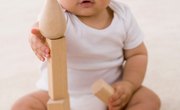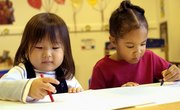Educator, disciplinarian, social support and comforter. While these are certainly main roles that a day care teacher plays, early childhood educators also assess and evaluate their students' learning and development. Teachers should use assessment measures that are developmentally appropriate, relate to everyday activities and are inclusive, the National Association for the Education of Young Children suggests. Creating a checklist can help you to know what to look for and when to look for it during the evaluation process.
Development By Age
An early childhood evaluation can assess the young student's strengths, areas for improvements and general development. When creating a checklist, include the different developmental domains -- cognitive, emotional, social and physical -- and the milestones by age. Avoid narrowing the development or learning area to a few specific random skills, notes NAEYC. The items that you are looking for must fit into the child's age range and the developmental expectations for him. For example, a 2-year-old should have the ability to walk alone, run and kick a ball, according to the American Academy of Pediatrics' HealthyChildren.org website. These physical milestones are acceptable to add to your toddler checklist, but not to an evaluation for an infant. You can have one developmental checklist or break each domain into its own separate evaluation.
The State Standards
Match up the areas for evaluation with developmental goals that you have set at the beginning of the school year and your state's early learning standards. Your checklist may include the specific standards for your age group. For example, an older toddler should have the cognitive ability to explore objects and ask questions about her discoveries, according to the "Pennsylvania Learning Standards for Early Childhood for Infants and Toddlers." If you work with older 2-year-olds, then you would include this item to check off your list.
Everyday Activities
Conducting an evaluation in the child's natural setting provides an authentic picture of her development, behavior and ability to learn, according to NAEYC. A day care assessment checklist should include what observations you will make and where, notes the Northwest Evaluation Association in its "Early Childhood Assessment: Implementing Effective Practice" guide. For example, your evaluation may list specific times of day to observe certain behaviors such as the child's social interactions at lunch or his interest in exploring during center choice time.
Get Input From Parents and Assistants
You aren't always the only one to include as "evaluator" on your day care assessment. Parents and paraprofessionals who work with you can also participate in the evaluation process, according to Washington state's "A Guide to Assessment in Early Childhood." Include checklist items for yourself as well as other people who may help you create an overall or complete picture of the child's development. For example, create a section for your assistant to assess behaviors that she sees when she interacts with the children, or ask the parents a few questions about the areas you are reviewing. Combine this information with what you're observing to create a full evaluation.
Related Articles
References
- National Association for the Education of Young Children: Early Childhood Curriculum, Assessment, and Program Evaluation
- Pennsylvania Early Learning: Pennsylvania Learning Standards for Early Childhood for Infants and Toddlers
- HealthyChildren.org: Developmental Milestones: 2 Year Olds
- Northwest Evaluation Association: Early Childhood Assessment: Implementing Effective Practice
- Washington State: A Guide to Assessment in Early Childhood
Writer Bio
Based in Pittsburgh, Erica Loop has been writing education, child development and parenting articles since 2009. Her articles have appeared in "Pittsburgh Parent Magazine" and the website PBS Parents. She has a Master of Science in applied developmental psychology from the University of Pittsburgh's School of Education.











